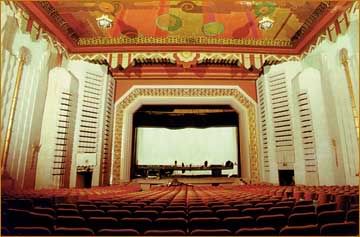On New Year's Eve, Tucson celebrated the restoration and reopening of the Fox Theatre, its historic downtown movie palace:

 http://www.foxtucsontheatre.org
Fox reopening is Downtown milestone
http://www.foxtucsontheatre.org
Fox reopening is Downtown milestone
The star's view: The newly restored and renovated Fox Theatre may help draw more people to the Downtown area after dark.
Arizona Daily Star
1.01.2006
This weekend's grand reopening of the Depression Era Fox Theatre Downtown is momentous. The building itself is a fine restoration, but its completion, or near completion — there is still minor work to be done — puts the finishing touch on one entire block of Tucson's bedraggled Downtown, a milestone in the city's revitalization effort.
It is now possible to walk the short distance from Stone Avenue to Church Avenue on Congress Street and feel the kind of bustle and excitement the city has been striving for decades to revive. After six years and an investment of $13 million, the Fox is arguably the jewel in the crown of the street it occupies. Once it starts booking events on a regular basis, it should generate lots of business for Downtown restaurants, especially its immediate neighbors to the west and east.
Once upon a time, it did just that. Construction of the movie house started just before the stock market crash of 1929 and was completed in 1930, a time when Downtown was the center of Tucson. Had the Fox's birth been delayed just a little longer, it's unlikely anybody — assuming they were still solvent — would have risked the $300,000 it cost for construction.
The theater that opened this weekend is not the place some Tucsonans remember from their youth. More will remember the place as it was in the 1950s or as the musty, water-damaged shambles it had become by the time it closed in 1974. Within 20 years of closing, the dim and dusty interior had become a sort of dormitory for homeless people who wandered the streets by day and returned to the Fox at night. There is not a hint of that past in the restored theater.
To qualify for designation as a historic structure, a staff of researchers and artisans under the tenacious leadership of Herb Stratford, executive director of the Fox Tucson Theatre Foundation, spent six years peeling back the more modern layers to find the original 1930s art-deco design. Gradually, the auditorium was restored to a subtle blend of deep reds and golds and stylized motifs that suggest Southwestern themes. New, wider seats were installed, an elevator was added to the orchestra pit, dressing rooms were built, and a 1926 Wurlitzer organ will be brought in next summer. In the days of silent movies, the organ was used to enhance the drama of the speechless actors on the big screen.
The theater will be used for movies, concerts, film festivals, children's programs and drama. As a performance space, the only comparable local facilities are the Alice Holsclaw Theatre in the restored Temple of Music and Art, at 330 S. Scott Ave., home to the Arizona Theatre Co., and the renovated auditorium at Tucson High Magnet School at 400 N. Second Ave.
The Fox's 1,200 seating capacity — about twice the size of the Temple of Music and Art and half that of Centennial Hall at the University of Arizona — meets the area's need for a medium-sized performance space. A couple of UApresents musical events will be staged at the Fox in February and April, and those who attend will be impressed by the superior acoustics.
The money for the restoration came from a combination of federal and local grants, a hefty loan from the city and donations from individuals and businesses. The $13 million investment is a pittance compared with the hundreds of millions of dollars now being discussed for other Downtown projects, including the UA Science Bridge and modifications to Interstate 10.
If the Fox draws more people Downtown, the return on that investment will ripple through the economy for many years to come.